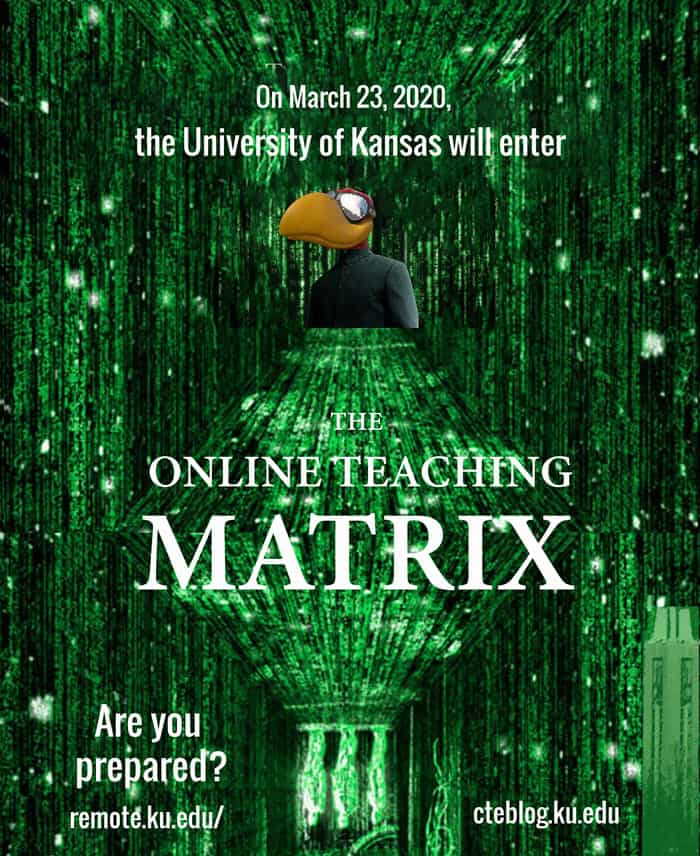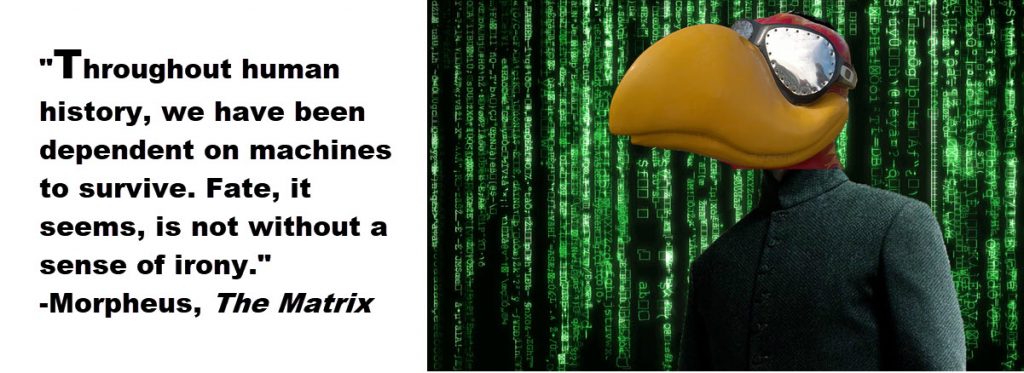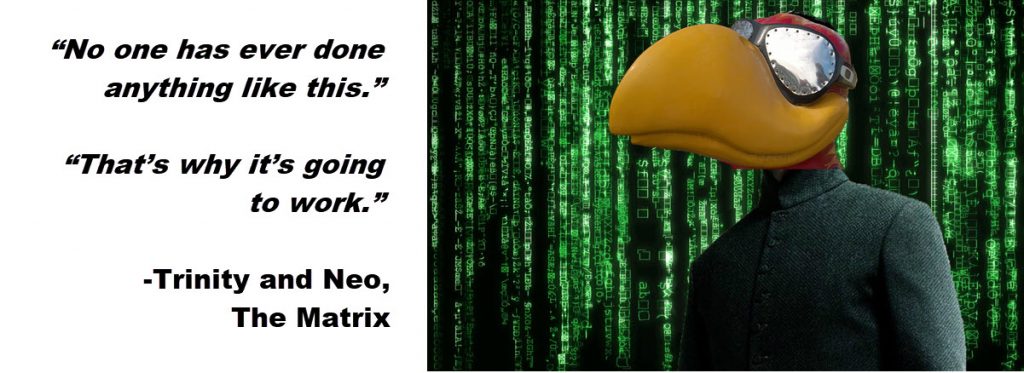By Doug Ward
Take a deep breath. You are about to launch into an online adventure.
Yes, I know, you didn’t want to take this trip. The corona virus – and the university – made you do it. Like it or not, though, we are all on the same trip, one that will take us deep into the uncharted territory of a quickly deployed online teaching and learning matrix of enormous scale. This involves not just the University of Kansas, but hundreds of colleges and universities around the world.
Despite the less-than-ideal circumstances, you can still help your students learn online. Despite your wariness of the medium, you can succeed as an online teacher. I’m not trying to be Pollyannaish. (Maybe a little.) Rather, I see this as an opportunity for all of us to break out of ruts we get into in the classroom, examine what we want our students to learn, and consider new ways of accomplishing those goals.
We also have an opportunity to model the types of behavior we want our students to adopt in the face of adversity. They will encounter many challenges in their lives, just as we have, and they are looking to us for guidance not only on college-level learning but on coping with the realities of a global pandemic, economic turmoil, social distancing, and sudden isolation in a world that had been growing more closely connected.
Are you up to the challenge?
Many students don’t think you can do it. . Here’s what one of them had to say last week on Twitter.
“You’re telling me my professor who can’t stop the YouTube autoplayer from playing the next video is going to teach classes online? This should be good.”
That post has been retweeted more than 100,000 times and had drawn nearly 600,000 likes by the weekend. It also attracted a slew of similarly frustrated students who poked fun at their teachers’ technical inadequacies with online grade books, YouTube, web browsers, volume controls, email, and seemingly anything that worked with bits and bytes. (My favorite: The instructor who uses Yahoo to search for Google so he can search for something he wants to show the class.)
“I have no expectations for ANY of my teachers,” one student wrote.
“Pray for the IT department,” wrote another.
Teachers fired back with their own zingers. One wrote:
“You’re telling me my students who can’t pay attention for 2 minutes even while I practically hold their hand through new content are going to have to learn on their own time? This should be good.”
‘We’re all trying really hard’
As the number of zingers grew, though, the tenor of the conversation began to shift. More instructors and instructional designers began to chime in. Many of them had their own doubts about whether this enormous online experiment would work.
Some talked about the overwhelming task of moving classes online at the last minute. An adjunct who teaches at several schools, each with a different online system, said she was struggling to figure out how to get her classes up and running. Retired professors expressed compassion for their former colleagues, with one saying the reason he retired was that he was no longer up to the technological challenge. Others pleaded for patience.
“We’re all trying really hard,” one instructor said.
Instructional designers wrote about putting in long days to try to make the switch possible. One wrote: “You’re the reason I do this work. I promise I’m doing my best for you.”
A time for compassion
In a single Twitter thread, you see nearly all the directions the next few weeks could take: humor, anxiety, sniping, denial, helplessness, surrender, bitterness, resolve and, yes, even hope.
“Oh, have a heart,” said Jenna Wims Hashway, a law professor at Roger Williams University in Rhode Island. “We’re doing the best we can. I say this as someone who is absolutely certain to screw up this technology that I’ve never used before. But I’m willing to try anything and look like an ass if it means I can teach my students what they need to know.”
No one has all the answers you are looking for as you try to figure out how best to transfer your classroom work online. (There is lots of help available, though.) Students are just as worried as you are about what this will mean for their classes, their learning, their degrees, their graduation, and their lives.
It’s up to you to model what you want to see in your students. If you complain, they will complain. If you show a sense of humor, many of them will still complain. Expect that, and move beyond it.
What you can do
We are taking on what The Chronicle of Higher Education called “the great online-learning experiment” as we are being told to distance ourselves physically from others. That’s intimidating and mentally taxing for instructors and students. Here are some ways you can break through that.
Don’t let the physical distance become mental distance. Campus is strangely silent. The hallways in our buildings are empty. Many of us are working from home. Many of the regular social activities we rely on have been shut down. All of that isolation can take a mental and emotional toll if you let it. So remember to engage with colleagues and your students. Share your feelings. Ask for help when you need it. Join the many workshops we will have on campus and online this week or the many online communities that have popped up to help with online teaching. And take a walk occasionally. Spring is nearly here. Your teaching has become virtual, but you still live in a physical world.
Give yourself a break. One of the challenges of online teaching is that it can feel like class is always in session. You have to set boundaries and establish new routines. Decide when you will engage with class work and when you will do other things. Tell students when you will be available and when you will not. And set aside time for yourself. Don’t let the things that keep you mentally and physically agile slip away.
Work at creating community. This is perhaps the most important thing you can do in any class. Students need to feel that they are part of a learning community. They need your trust and your guidance. They need to know you have a plan – even a tenuous one – to make this work. They need to know that a human being is paying attention beyond the glow of the computer screen. So communicate with students often through whatever means works best for your class. Keep them apprised of your plans. Tell them to expect lots of twists and turns. Tell them that you will be flexible with them and that they should be flexible with you. And remind them not to let the physical distance become mental distance – and to give themselves a break.
Where to find assistance
Remember, you don’t have to do this alone. There is an abundance of resources available and many people to offer assistance. The best teaching and learning happens as part of a community, and CTE, the Center for Online and Distance Learning, and KU Information Technology are working to bolster that community. We have planned several workshops over the coming week (with more to follow). You’ll find those, along with many other resources to guide you into online teaching, on a new website we created last week.
If you haven’t visited the site, you should. It’s a great place to start if you’ve never taught online before, and it’s a great place to get new ideas if you have. If you need help, the site provides contact information for those of us who can help. We will continue to add material and update the workshops we are planning over the coming weeks. I will also be providing advice through this blog, trying to address myths about online teaching, offer ways to create community in online classes, and suggesting tools you might try to Also let us know what you want to know about online teaching so we can provide the types of materials you and your colleagues need.
Doug Ward is the associate director of the Center for Teaching Excellence and an associate professor of journalism. You can follow him on Twitter @kuediting.




Recent Comments